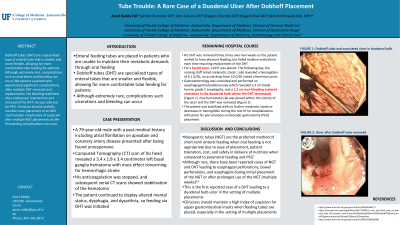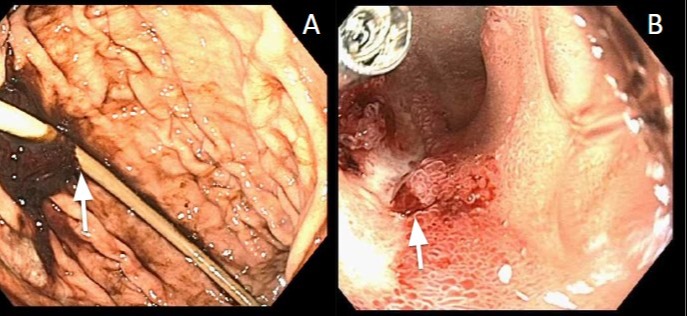Sunday Poster Session
Category: Esophagus
P0572 - Tube Trouble: A Rare Case of a Duodenal Ulcer After Dobhoff Placement
Sunday, October 27, 2024
3:30 PM - 7:00 PM ET
Location: Exhibit Hall E

Has Audio

Anvit D. Reddy, DO
University of Florida College of Medicine
Jacksonville, FL
Presenting Author(s)
Anvit D. Reddy, DO, Landen Shane Burstiner, DO, MSc, John Sousou, DO, Gregory Churchill, DO, Maged A.. Ghali, MD, Mehdi Mirsaeidi, MD, MPH
University of Florida College of Medicine, Jacksonville, FL
Introduction: Enteral feeding tubes are placed in patients who cannot maintain their metabolic demands through oral feeding. Dobhoff tubes (DHT) are a specialized type of enteral tube that is smaller and more flexible, allowing for more comfortable tube feeding for patients. Although extremely rare, complications such as ulcerations and bleeding can occur. We present a patient who experienced significant complications after DHT placement.
Case Description/Methods: A 79-year-old male with past medical history including atrial fibrillation on apixaban presented to the hospital after being found unresponsive. A Computed Tomography (CT) scan of his head revealed a 3.4 x 1.8 x 3.4 centimeter (cm) left basal ganglia hematoma with mass effect. His anticoagulation was stopped, and he was admitted for the management of hemorrhagic stroke. Subsequent serial CT scans showed stabilization of the hematoma. The patient continued to display altered mental status, dysphagia, and dysarthria, so feeding via Dobhoff Tube (DHT) was initiated. His DHT was removed three times over two weeks as the patient wished to have pleasure feeding, but failed swallow evaluations each time requiring replacement of the DHT. For a fourth time, a DHT was placed and was confirmed to be in the correct position without any complications. The following day, the nursing staff noted melanotic stools. Labs revealed a hemoglobin of 6.1 G/DL, which was an acute drop from 10 G/DL noted a few hours prior. Gastroenterology was consulted and performed an esophagogastroduodenoscopy (EGD) which revealed a 3 cm hiatal hernia, grade C esophagitis, and a 1.5 cm non-bleeding cratered ulceration in the duodenal bulb where the DHT terminated. One hemostatic clip was placed near the ulcer, the DHT was removed, and the patient was stabilized with no further melanotic stools or decreases in hemoglobin during the rest of his hospitalization.
Discussion: Although rare, there have been reported cases of nasogastric tubes and DHT leading to esophageal perforations, bowel perforations, and esophagitis. In those cases, organ injury occurred either during the initial placement of the NGT or after prolonged use of the NGT (multiple weeks). This is the first reported case of a DHT leading to a duodenal bulb ulcer in the setting of multiple placements. Clinicians should carefully consider each placement of an NGT and maintain a high index of suspicion after multiple NGT placements as life-threatening complications can occur.

Disclosures:
Anvit D. Reddy, DO, Landen Shane Burstiner, DO, MSc, John Sousou, DO, Gregory Churchill, DO, Maged A.. Ghali, MD, Mehdi Mirsaeidi, MD, MPH. P0572 - Tube Trouble: A Rare Case of a Duodenal Ulcer After Dobhoff Placement, ACG 2024 Annual Scientific Meeting Abstracts. Philadelphia, PA: American College of Gastroenterology.
University of Florida College of Medicine, Jacksonville, FL
Introduction: Enteral feeding tubes are placed in patients who cannot maintain their metabolic demands through oral feeding. Dobhoff tubes (DHT) are a specialized type of enteral tube that is smaller and more flexible, allowing for more comfortable tube feeding for patients. Although extremely rare, complications such as ulcerations and bleeding can occur. We present a patient who experienced significant complications after DHT placement.
Case Description/Methods: A 79-year-old male with past medical history including atrial fibrillation on apixaban presented to the hospital after being found unresponsive. A Computed Tomography (CT) scan of his head revealed a 3.4 x 1.8 x 3.4 centimeter (cm) left basal ganglia hematoma with mass effect. His anticoagulation was stopped, and he was admitted for the management of hemorrhagic stroke. Subsequent serial CT scans showed stabilization of the hematoma. The patient continued to display altered mental status, dysphagia, and dysarthria, so feeding via Dobhoff Tube (DHT) was initiated. His DHT was removed three times over two weeks as the patient wished to have pleasure feeding, but failed swallow evaluations each time requiring replacement of the DHT. For a fourth time, a DHT was placed and was confirmed to be in the correct position without any complications. The following day, the nursing staff noted melanotic stools. Labs revealed a hemoglobin of 6.1 G/DL, which was an acute drop from 10 G/DL noted a few hours prior. Gastroenterology was consulted and performed an esophagogastroduodenoscopy (EGD) which revealed a 3 cm hiatal hernia, grade C esophagitis, and a 1.5 cm non-bleeding cratered ulceration in the duodenal bulb where the DHT terminated. One hemostatic clip was placed near the ulcer, the DHT was removed, and the patient was stabilized with no further melanotic stools or decreases in hemoglobin during the rest of his hospitalization.
Discussion: Although rare, there have been reported cases of nasogastric tubes and DHT leading to esophageal perforations, bowel perforations, and esophagitis. In those cases, organ injury occurred either during the initial placement of the NGT or after prolonged use of the NGT (multiple weeks). This is the first reported case of a DHT leading to a duodenal bulb ulcer in the setting of multiple placements. Clinicians should carefully consider each placement of an NGT and maintain a high index of suspicion after multiple NGT placements as life-threatening complications can occur.

Figure: Esophagogastroduodenoscopy showing a 15-millimeter non-bleeding cratered ulceration in the duodenal bulb with the dobhoff tube (DHT) in place (A) and after removal of the DHT (B)
Disclosures:
Anvit Reddy indicated no relevant financial relationships.
Landen Shane Burstiner indicated no relevant financial relationships.
John Sousou indicated no relevant financial relationships.
Gregory Churchill indicated no relevant financial relationships.
Maged Ghali: Gilead – Grant/Research Support. Madrigal – Grant/Research Support. Novo Nordisk – Grant/Research Support.
Mehdi Mirsaeidi indicated no relevant financial relationships.
Anvit D. Reddy, DO, Landen Shane Burstiner, DO, MSc, John Sousou, DO, Gregory Churchill, DO, Maged A.. Ghali, MD, Mehdi Mirsaeidi, MD, MPH. P0572 - Tube Trouble: A Rare Case of a Duodenal Ulcer After Dobhoff Placement, ACG 2024 Annual Scientific Meeting Abstracts. Philadelphia, PA: American College of Gastroenterology.
